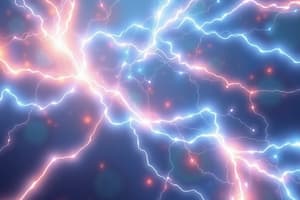Podcast
Questions and Answers
What does Kirchhoff's Voltage Law (KVL) state?
What does Kirchhoff's Voltage Law (KVL) state?
- The voltage across any element is equal to the current flowing through it.
- The total work performed in moving a test charge around a closed path is non-zero.
- The sum of voltages across elements in a closed loop is non-zero.
- The sum of voltages around every closed loop in the circuit must equal zero. (correct)
In KCL equations, which node is typically discarded to avoid redundancy?
In KCL equations, which node is typically discarded to avoid redundancy?
- The node at the top of the circuit
- The node at the bottom of the circuit (correct)
- The node with the lowest voltage
- The node with the highest voltage
What is the purpose of adding or subtracting two KCL equations?
What is the purpose of adding or subtracting two KCL equations?
- To double the number of variables
- To simplify the circuit analysis (correct)
- To introduce errors in calculations
- To complicate the circuit analysis
What does an element's voltage entering with a plus sign indicate in KVL?
What does an element's voltage entering with a plus sign indicate in KVL?
What does it mean when a KCL equation states i1 = iout?
What does it mean when a KCL equation states i1 = iout?
In circuit analysis, what happens when the KCL equations are contradictory?
In circuit analysis, what happens when the KCL equations are contradictory?
How many v-i relations are there in the example circuit shown in Figure 6?
How many v-i relations are there in the example circuit shown in Figure 6?
What is the significance of following the convention in writing KVL equations?
What is the significance of following the convention in writing KVL equations?
What does it mean for electric fields to be conservative according to KVL?
What does it mean for electric fields to be conservative according to KVL?
How many KVL equations are typically needed for solving circuits like the one in Figure 6?
How many KVL equations are typically needed for solving circuits like the one in Figure 6?
Flashcards are hidden until you start studying




